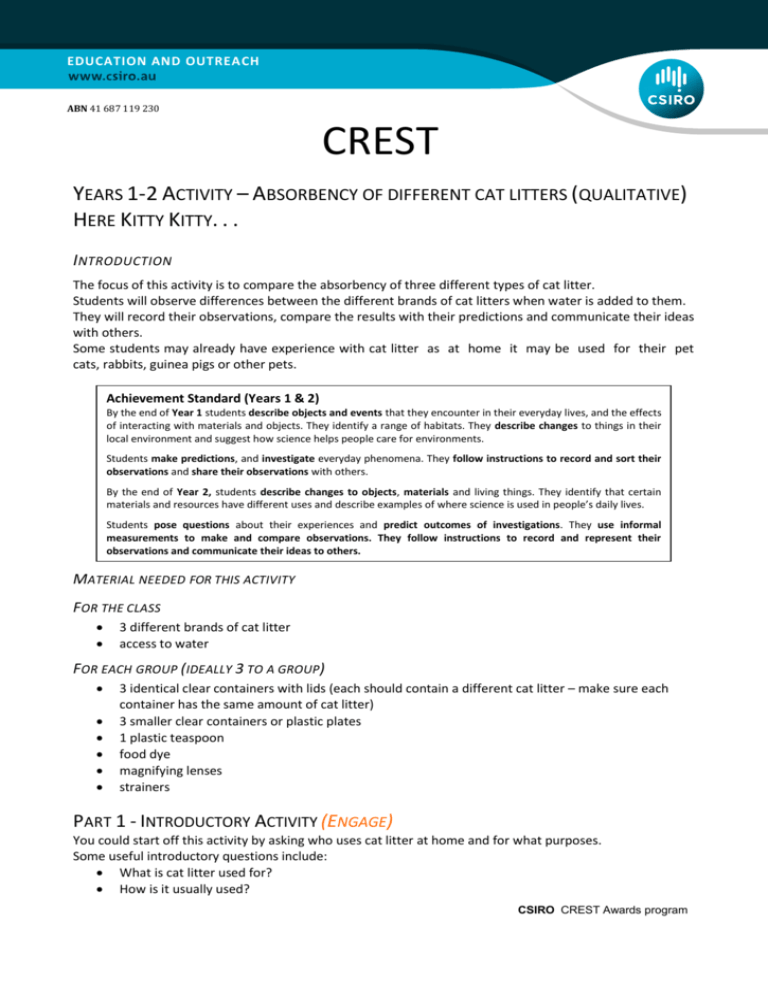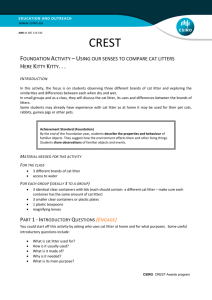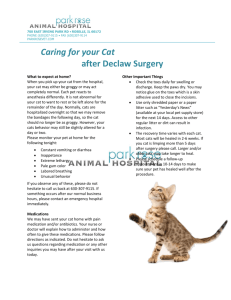Year 1-2 CREST Activity
advertisement

EDUCATION AND OUTREACH EDUCATION AND OUTREACH ABN 41 687 119 230 CREST YEARS 1-2 ACTIVITY – ABSORBENCY OF DIFFERENT CAT LITTERS (QUALITATIVE) HERE KITTY KITTY. . . I NTRODUCTION The focus of this activity is to compare the absorbency of three different types of cat litter. Students will observe differences between the different brands of cat litters when water is added to them. They will record their observations, compare the results with their predictions and communicate their ideas with others. Some students may already have experience with cat litter as at home it may be used for their pet cats, rabbits, guinea pigs or other pets. Achievement Standard (Years 1 & 2) By the end of Year 1 students describe objects and events that they encounter in their everyday lives, and the effects of interacting with materials and objects. They identify a range of habitats. They describe changes to things in their local environment and suggest how science helps people care for environments. Students make predictions, and investigate everyday phenomena. They follow instructions to record and sort their observations and share their observations with others. By the end of Year 2, students describe changes to objects, materials and living things. They identify that certain materials and resources have different uses and describe examples of where science is used in people’s daily lives. Students pose questions about their experiences and predict outcomes of investigations. They use informal measurements to make and compare observations. They follow instructions to record and represent their observations and communicate their ideas to others. MATERIAL NEEDED FOR THIS ACTIVITY FOR THE CLASS 3 different brands of cat litter access to water FOR EACH GROUP (IDEALLY 3 TO A GROUP) 3 identical clear containers with lids (each should contain a different cat litter – make sure each container has the same amount of cat litter) 3 smaller clear containers or plastic plates 1 plastic teaspoon food dye magnifying lenses strainers PART 1 - INTRODUCTORY ACTIVITY (ENGAGE) You could start off this activity by asking who uses cat litter at home and for what purposes. Some useful introductory questions include: What is cat litter used for? How is it usually used? CSIRO CREST Awards program EDUCATION AND OUTREACH EDUCATION AND OUTREACH ABN 41 687 119 230 CREST What is it made of? Why is it needed? What is its main purpose? Give each group a set of the three clear containers that contains the different cat litter. Let them have a closer look at the three different samples. Ask students to come up with some words that describe the different cat litters. Focus questions What colour is it? What is the texture like? Are all three the same? How are they different? Which has the biggest pieces? What do you think they are made of? Ask students to take out a small amount of the cat litter and place it in the smaller container or plastic plate. Ask the students to have a closer look with the magnifying lenses and to feel the cat litter. Focus questions What else can you see? What does the cat litter feel like? Is it smooth? Is it gritty? Write these words on the board. A worksheet like the one below could be used for the students to draw the three types of cat litter and copy the describing words. Cat Litter Sample Drawing of Cat Litter Describing words Sample A Sample B Sample C CSIRO CREST Awards program EDUCATION AND OUTREACH EDUCATION AND OUTREACH ABN 41 687 119 230 CREST PART 2 – ABSORBENCY OF DIFFERENT CAT LITTERS (EXPLORE, EXPLAIN) a) Ask a class group ask students to predict what will happen when water is added to the different cat litters. Focus questions What do you think will happen when water is added to the cat litter? Why do you think this will happen? Which cat litter sample do you think will absorb the most liquid? Record their predictions on the board and ask them to write their own prediction in their book or worksheet. b) Show students the materials you have available for this activity. Encourage them to explore the different materials. c) Ask them to think about how they could check, using some of or all of the available material, how much water each of the different cat litters can absorb. If they are struggling to come up with ideas use the below suggested method. 1. Give each group the following material: 3 x 3 plastic cups each containing a different cat litter. Make sure each cup is filled to the same level of cat litter. 3 x 3 plastic cups filled with the same amount of water. You can add 2 – 3 drops of food colouring to these. a strainer a plastic bowl 2. Ask the students to pour one of the cat litter samples into the strainers. Hold the strainer above a plastic bowl. At the same time, pour the coloured water from the plastic cup onto the cat litter in the strainer and collect the water runoff in the plastic bowl. Pour this runoff water back into the now empty plastic cup. And repeat the experiment again with the other two samples of the same cat litter. 3. 4. Repeat step 2 with each of the other two cat little samples. Compare the collected water samples. GROUP DISCUSSIONS In their small groups ask students to think about and respond to the following Focus questions What were the differences between the amounts of water soaked through for the different cat litter types? Put them in order from most water through (1) to least water through (3). Write this order onto the table below, which could be included on the worksheet. CSIRO CREST Awards program EDUCATION AND OUTREACH EDUCATION AND OUTREACH ABN 41 687 119 230 CREST Cat Litter Sample Test 1 Test 2 Test 3 Sample A Sample B Sample C PART 3 – CLASS DISCUSSION (ELABORATE & EVALUATE) What did the different cat litters look like once they were wet? In what ways were the cat litters different when they were wet? What else did you notice? Compare your results to the rest of the class. Write on board. Were everyone’s results the same? If they were different, why do you think they were different? Were your results the same as what you predicted at the start? Why did we repeat it three times? A SSESSMENT R UBRIC This assessment rubric links is based on the content descriptors of the Science Inquiry Skills strand of the Australian Curriculum: Science It is provided as guide for you to use with the above activity. Please feel free to adapt or develop your own rubric to use with your students. Science Inquiry Skills Questioning and Predicting Developing Consolidating Struggles to respond to or pose questions or make predictions about the absorbency of the cat litters, even with prompting Minimally responds to and pose questions and make predictions about the absorbency of the cat litters. Requires prompting. Achieving Respond to and pose questions and make predictions about the absorbency of the cat litters. CSIRO CREST Awards program EDUCATION AND OUTREACH EDUCATION AND OUTREACH ABN 41 687 119 230 CREST Planning and Conducting Processing and Analysing Data and Information Evaluating Communicating Does not participate in the investigation and does not successfully take measurements or record observations, even with assistance. Participates minimally in the investigation. Has limited success taking measurements and collecting and recording observations. Requires teacher assistance. Actively participates in the investigation to test the absorbency of different soils. Fails to use drawings and worksheets to sort information. Has limited success using drawings and worksheets to sort information. Use drawings and provided worksheets to sort information. Needs much prompting to participate in discussions. Participates minimally in discussions. Use informal measurements in the collection and recording of observations. Participates in discussions comparing what was found to what was predicted. Needs help to compare observations with those of others. Has some success comparing observations with those of others. Compare observations with those of others. Struggles to represent and communicate observations and ideas, even with help. Has some success representing and communicating ideas. Represent and communicate observations and ideas by participating in class discussion. This activity also links to the following in the Australian Curriculum: Science Science as a Human Endeavour Science Understanding Nature and development of science Science involves asking questions about, and describing changes in, objects and events Chemical Sciences Use and influence of science People use science in their daily lives, including when caring for their environment and living things. Chemical Sciences (Year 1) (Year 2) Everyday materials can be physically changed in a variety of ways. Different materials can be combined, including by mixing, for a particular purpose. CREST Link This activity leads into the Green CREST Science Activity in the Pets and Other Animals topic. A copy of the activity is available in the Introductory CREST Teacher Handbook. More information about CREST is available at www.csiro.au/crest CSIRO CREST Awards program





